Finland under Swedish rule
Finland under Swedish rule refers to the period in the history of Finland when it was a part of Sweden. It has traditionally been considered as starting from 1150, when according to the legend of St. Erik the king Eric IX of Sweden and the bishop Henry arrived in Finland. The actual starting point of the Swedish rule is however under a large amount of uncertainty and controversy. Clear historical evidence of the establishing of Swedish rule in Finland exist from 1249 onwards, when the second crusade to Finland happened. The period of Swedish rule ended in the Finnish war in 1808–1809.
Swedish-ruled Finland has in the 20th century also been referred to as "Sweden-Finland". The term has been used to refer to the realm consisting of the main parts of current Sweden and Finland. The historian Peter Englund has noted that Swedish-ruled Finland was not so much part of a national union or a province as "the eastern half of the realm which was practically destroyed in 1809, when both parts went on along their separate ways." Englund thinks that the period of Sweden as a superpower was the common "property" of Sweden and Finland, because the rise as a superpower would have been impossible for a poor nation without the resources of the eastern part of the realm.[1]
As a part of Sweden, Finland was annexed as part of the Western Christian domain and the cultural, communal and economic order of Western Europe, on which the market economy, constitutional governments and legalistic principles were founded. Finland was the eastern frontier of the realm, which brought many wars and raids to the areas. The Finnish language, dating from prehistoric times, and some parts of folklore religion and culture remained under Swedish rule, even though they changed as they adapted to new circumstances.[2] For example, in this period Finnish adopted the Latin alphabet as its writing system and a huge amount of Swedish loanwords.
Medieval times (c. 1150–1523)
Finland becomes part of Sweden
Introduction of Christianity
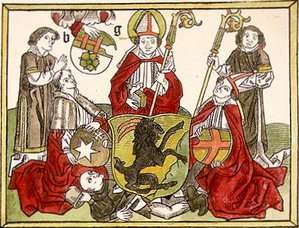
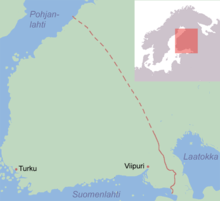
The written history of Finland is said to have begun at the 12th century, because the earliest remaining documents discussing the area that became Finland date from that time. Up until the 14th century, information about Finland has been incomplete and unreliable. The latter part of the 12th century and the 13th century are sometimes called Finland's protohistory, because they are situated between the pure prehistory and diverse written sources.
According to the legend of Eric the Holy, the King of Sweden Eric the Holy began the conquest of Finland by making the first crusade to Finland to southwest Finland in the 1150s. According to the chronicle and other fabulous sources, the bishop Henry was converting people to Christianity in the areas of Finland Proper and Satakunta during the crusade. There has been controversy over the factualness of this information.
Establishing the Christian church as an institution in Finland has probably caused some resistance in the native Finnish population, as told in the legend of the peasant Lalli. It is however probable that the western or eastern Christianity had spread to Finland already during Finland's prehistory. There have been hints about this for example in graves found during archaeological diggings. The old-fashioned romantic nationalist view of a quick conquest of Finland and forced conversion to Christianity is a bit misleading. The Kingdom of Sweden was only starting to form in the 12th century. The area what is now Finland moved to or formed as a part of the Swedish realm gradually during the 12th or 13th century. Most native people in the area spoke Finnish or Sami dialects. The Finnish-speaking population probably did not have a common identity.[3]
Establishment of Swedish rule
In the 13th century, Sweden made crusades to Western Finland or Tavastia (second crusade to Finland) and to Karelia (third crusade to Finland). Apparently this caused the Swedish rule to be finally established. By approximately 1300, what is now Western and Southern Finland, up to the Karelian isthmus, had become part of Sweden and the Uppsala diocese, which was ruled from castles. The Käkisalmi area and the Ladoga Karelia retained their ties to the Orthodox southwest Russia and to Novgorod. The collision between the Catholic and the Orthodox cultures happened in the area that is now Finland. The Treaty of Nöteborg, made in 1323, was the first peace treaty between Sweden and Novgorod. It also defined the eastern boundary of the Swedish realm and Finland at least for Karelia. The boundary in northern Finland remained unclear. However, Sweden annexed the Finnish population on the shores of Northern Ostrobothnia in the 14th century to its realm.
Finland cannot be defined as a single, continuous government area at this point. The eastern part of Sweden was not commonly called Suomi or Finland in the 14th century, this name referred to the region of Finland Proper. The larger area of Southern Finland was at first called Österland (East land).
Finland as part of the Kingdom of Sweden

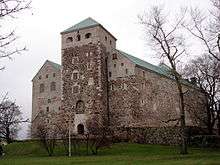
To help establish the power of the King of Sweden, three castles were built: the Turku Castle in Finland Proper, the Häme Castle in Tavastia and the Vyborg Castle in Karelia. In mediaeval times the castles were important for the defence of Finland and they also acted as government centers in Finland. The government area surrounding a castle was called a slottslän (linnalääni in Finnish). Sweden was an electoral kingdom in mediaeval times and the election was held at the stones of Mora. Finns also received the right to send their representative to the election in 1362, which shows the established role of Finland as part of Sweden. The development of government and justice had a large role in the law established during the reign of king Magnus IV of Sweden.
In mediaeval times, the historical regions of Finland Proper and Satakunta were part of the central area of the Swedish government and retained the ties to Scandinavia they had formed already during prehistory. In Southwest Finland, Tavastia, southern Karelia there was permanent agricultural population, which gradually condensed and spread to a larger area. The spreading and establishment of the new population in Middle and North Ostrobothnia was one of the most notable events in the history of the Finnish population during the mediaeval ages. In Åland, the Turku archipelago and the coastal regions of Ostrobothnia and Nylandia there also was a Swedish-speaking population. In the mediaeval ages, peasants were by far the largest population group in Finland. A large part of the area of current Finland was a wilderness in mediaeval times, where people from Satakunta, Tavastia and Karelia held hunting trips, and which was inhabited by Lapps, at least some of which spoke Sami. The wilderness was not part of any government area in practical terms.
In the early times of the Swedish rule, official government documents were often written in Latin, which emphasised the role of the clergy also in secular government. The use of Swedish as a written government language increased during the 14th century. In local governments in cities, particularly concerning international trade, the Middle Low German language was also largely used. It is however impossible to present accurate approximations of the relations of different languages in mediaeval times.
The countryside and cities
Unlike the situation in central Europe, peasants in Sweden were free and feudalism never developed in the Swedish realm in the proportion it did in central Europe. The local government was based on local settlements (socken) and parishes in the countryside.
In the mediaeval times, the concept of cities was introduced to Finland. The bourgeoisie living in the cities, such as merchants and handicraft workers, only represented a small part of the population. The most important mediaeval cities in Finland were Åbo (Turku) and Viborg (Viipuri, Vyborg). Other cities were Naådendal (Naantali), Ramo (Rauma), Ulvila and Borgå (Porvoo). Faraway trade in Finland and other Nordic countries in the mediaeval times was mostly in the hands of German Hanseatic League merchants and as such a significant portion of the bourgeoisie in Åbo (Turku) and Viborg were Germans. In cities, the local government was in the hands of a court led by a mayor.
The frälse
The Ordinance of Alsnö, given during the reign of Magnus III of Sweden, established a small secular frälse (Finnish: rälssi) or nobility, freed from tax, in Sweden and Finland in 1280. The spiritual frälse meant spiritual people who were exempt from paying tax to the secular government (such as priests, nuns and beggar brothers).
The parishes of the Catholic church in the area of Finland belonged to the Archdiocese of Turku. The bishop of Turku, the head of the diocese, had as well as power over the church, a large amount of secular power, and he was a member of the Privy Council of Sweden. One of the most notable mediaeval bishops of Turku was Magnus II Tavast, who held the office from 1412 to 1450. The spiritual frälse were the educated, literate intellectuals in mediaeval Finland. Its members had often attended the Turku cathedral school and some had also studied in foreign universities.
The age of the Kalmar Union
Finland as part of the Kalmar Union
_effigy_2010_(2).jpg)
The Nordic Kalmar Union was founded by Queen of Denmark Margaret I in 1397. In practice, conflicts arose within the union, as the Swedish high classes with their expansion policy were interested in the east, the direction of Russia, whereas the Danish were more interested in the south – the direction of the German lands. There were also internal conflicts between the high class of individual nations. The struggle to power was not only the result of "foreign political" differences in modern parlance.
Even in the union age, Finland did not form a continuous governmental area but was divided into two separate governmental districts. Vyborg acted as a significant, sometimes almost independent centre, whereas Turku was a more integral part of the governmental area of the central authority. According to Kauko Pirinen, "In the decentralised union nation Finland was also decentralised. In practical terms, it was not a continuous political entity."
The independent position of Vyborg was evident in that although Finland was divided into two separate lawspeaker areas, Southern and Northern Finland, in 1435, Vyborg had its own independent Karelian lawspeaker area already in the 1440s, with the lawspeaker probably appointed by the chief of the Vyborg Castle. However, the Karelian lawspeaker had no authority in the Turku land court.[4]
In the union age, Finland's position as part of the realm changed. For four decades, the monarch's grasp of Finland was tighter than before. King Eric of Pomerania visited Finland twice, in 1403 and in 1407. With the union, the leading authorities in Finland also changed, as the king placed his own trustees to lead the castles. Abraham Broderson rose as the chief of the Turku Castle and the Danish Klaus Fleming was appointed as lawspeaker. Later, Klaus Lydekesson Djäkn and Krister Nilsson Vasa rose to significant positions. The bishop Magnus II Tavast was a supporter of the union power.
The community under the union times
The frälse and the clergy formed the leading political group under the union times. Finland's own frälse only rarely ruled over larger slottslän, which were mostly ruled by Swedes or Danes, sometimes even German-born men, who had however lived in Finland for decades. The Finnish frälse was mostly responsible for the lower government, military duty and especially justice. The most significant duties in the church were also assigned to sons of the Finnish frälse under the union times. However, peasants could also participate in the activities of different courts and have an effect in political decisions, such as the election of the king.
Apart from Turku and Viborg, cities under union times were small, and numbered very few. As such, foreign trade was modest. Even Viborg could not compete with Reval (Tallinn) as the centre of Russian trade. Domestic trade was economically more significant than foreign trade.
Under the union times, the Finnish government was reorganised to help the economic situation. In 1405, hundreds of farms had their tax exemption status revoked. With this, the foundation for systematic agricultural taxing was created. The crown attempted to raise tax income also by settler activities: farming fields caused tax income, whereas work in the wilderness did not. Tax income could be raised by dealing out wilderness areas for permanent population. In 1409, Turku started minting its own money, which had a different value than the money used in the rest of Sweden. They were örtugs made of silver and six penny coins. In 1407, Finland got its own supreme court, the Turku land court, which was also given governmental powers. The leaders of Finland could now decide on their country's matters in their own meetings.
The union begins to fall apart
Externally, the early times of the Kalmar Union were a time of peace for Finland. With his active foreign policy, the king Eric of Pomerania ran into conflict with the Hanseatic League, which made trade more difficult. In the 1430s, the upper class and peasant rebel movements in Sweden did not really have an effect on Finland. The opposition to the upper class caused by the minor peasant rebel movements in Finland can be explained by the expansion of the property of the crown and the frälse.[5] The best known of these rebel movements was the so-called "David rebellion" in Tavastia in 1439. It was directed at the Viikki manor.[6][7]
No one from Finland participated in the Arboga meeting in 1435. In the same autumn, the bishop Magnus II Tavast and Krister Nilsson arrived in Sweden, and in the negotiations there they participated in the discharge of the leaders of the Engelbrekt Engelbrektsson rebellion and the forming of a compromise. Krister Nilsson became the drots (seneschal) and Karl Knutsson Bonde became the marshal. After Nilsson had returned to Finland in the same autumn, rebel movements started in Sweden again.
In order to fight the rebel movements, the Finnish peasants were promised a cut in taxes in a letter dated 24 June 1436, signed by the archbishop, the drots and the marshal, under authority from the government. The stated reason was that the Finns had proven to be loyal to the realm and sworn never to take up a leader of their own, and promised not to rise up in rebellion, and accepted the leader appointed by the government. Seppo Suvanto has interpreted this so that Sweden feared that the Finnish local government would detach itself from the Swedish realm and the Finns would choose a leader of their own.[8]
Clashes of power between Finland and Sweden
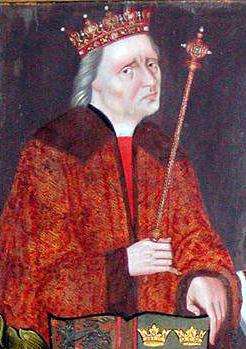

The king was finally deposed in 1439, after which Sweden was ruled by a council of aristocrats. It was composed of bishops and leading noblemen. The mightiest of this group was Karl Knutsson, who was elected leader of the realm in 1438. His biggest competitor, the drots Krister retreated to Vyborg after this. After the fall of the absolutist government, Finland's connections to Denmark were severed. However, the connections to Sweden were not really strengthened but local slottslän governors mostly ruled the country.
In 1440, the Danish invited Christopher of Bavaria to their country and elected him as their king. In Sweden, negotiations were being held about the conditions of his recognition. Charles VIII of Sweden moved to Finland in the same year and took hold of the Turku and Kastelholm castles, promising to denounce his position as leader of the realm if he were to receive the whole of Finland as his county. This wish was granted, apart from Åland. However, the situation changed very quickly, and Charles VIII had to contend himself with the Vyborg slottslän. Turku returned to the power of an official appointed by the king. The king's intention was to prevent the forming of a continuous Finland.
After Christopher died in 1448, Charles VIII sailed from Vyborg to Stockholm with 800 armed men, where he was elected king (1448 to 1457), apparently because of his military superiority. His term was marked by a war with Christian I of Denmark, which caused taxes to rise also in Finland. During this period, Finland was the king's most significant support area. In 1457, the Swedish high nobility rebelled against the king, and he fled to Danzig. Christian I was elected as king of Sweden. He ruled from 1457 to 1464. However, not all people supported the new king – especially in Vyborg.
Dispute over the eastern border
The next period was marked by problems in the eastern parts of the realm. As population spread to the wilderness, border disputes and fights with Novgorod and the Karelians started. As Savonian population spread, Northern Karelia was also populated. In 1478, Novgorod was annexed to Moscow, and a new power arose beyond the eastern border. To secure the border, the Olavinlinna castle was built to protect the new settlers. The Russians viewed this as a breach of the border treaty, and open war reigned for many ears until the interim peace in 1482. However, the parties could not agree on where the border was to be located.
From Axelsson to Sten Sture
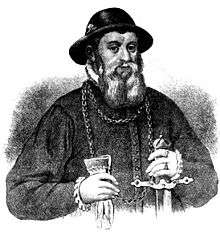
In the battle for the Swedish crown, Finnish castles were also conquered and persuaded to the union king's side. The Danish knight Erik Axelsson Tott came with his brothers to conquer castles in the 1480s, and in the end, all the castles were under the power of the Axelssons. After Erik's death he left the Vyborg, Hämeenlinna and Savonlinna counties to his brothers Ivar and Lauri, who already ruled over Raseborg. However, the formation of a continuous circle of power did not fit to the regent Sten Sture's plans. In 1481 Sten Sture arrived in Finland, all the way to Vyborg. The regent and the local governors could not come to an agreement: the regent promised tax cuts to the people; the local landowners could not accept this.
In the end of the union times, no regent had universal acceptance from all the Nordic countries any more. The King of Denmark John (reigned 1481–1513) was not accepted in the union countries, and the councils took power into their own hands. In 1483 Sten Sture received power over three counties in Finland: Vyborg, Savonlinna and Hämeenlinna. The former realm of the Axelssons became the regent's support area and Finland became an even more integral part of the central government; especially as even Raseborg came to the power of Sten Sture's supporter Knut Posse. Sture did not distribute the castles to the nobility, but ruled over them through officials dependent on him, gathering a significant amount of tax income to himself.
Unrest during the end of mediaeval times
In the late 15th century, previous skirmishes with Moscow escalated into a war. In 1495, the Vyborg Castle was sieged. People from Western Finland were also drafted to war. In threatened areas, all people over 15 years of age were called to arms, and in addition, German mercenaries and people from Sweden arrived in the country. The Russian attacks stretched from Karelia to Ostrobothnia, Savonia and Tavastia. Peace was made in 1497.
In the same year, the Privy Council of Sweden deposed Sten Sture as regent. However, the Finnish slottsläns remained under his control. A civil war followed, where King John beat the regent's troops, becoming King of Sweden himself (1497–1501). In 1499, Sture had to renounce his areas in Finland. In 1503, Svante Nilsson Sture (reigned 1504–1512) was elected as regent, and the Finnish leaders swore their loyalty to him. In a meeting held in Turku, the people showed their support for his position. However, the unanimity was only specious, as part of the leaders of Finland supported their own political standpoint together with Sten Sture's family. Their goals have remained somewhat unclear. However, national history has emphasised the role of eastern politics in the disagreements.
The age of Vasa (1523–1617)
The reign of Gustav Vasa
The final battles of the union
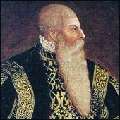

The final times of the union were a time of unrest in most of Finland, not only in Vyborg. In the late 16th century, the Danish went on pillages on the Finnish coast, and the pirate captain Otto Rudi robbed Turku and its cathedral's treasures. As the Danish union king Christian II of Denmark came to power, in his coronation he had tens of Swedish noblemen beheaded. This was called the Stockholm Bloodbath. The Swedish nobleman Gustav Vasa rose up to oppose the union king and won the peasants on his side. The German Hanseatic merchants also supported Gustav Vasa and provided him with weapons and money. The Finnish-born brothers Erik and Ivar Fleming conquered the Finnish castles for Gustav Vasa and drove the Danish away from Finland in 1523. The age of the Nordic union came to an end, and Gustav Vasa became king of Sweden and Finland.
An early modern state is born
During the reign of Gustav Vasa, a continuous Swedish realm started to form. He managed to suppress the regional communities who had been driving their own politics. In turn, the reformation suppressed the church. The high nobility, already weakened by the bloodbath, was now attached to support royal politics. However, the governing was still done in the medieval tradition: the king had numerous noblemen and scribes to help him, but these were not really officials. Also the government did not have a clear distinction of jobs, but tasks under the king's service changed according to the situation. In the 1530s, Gustav Vasa started to bring in German government officials to the country, along with whom new visions of royal power arrived in Sweden. During the 1544 Västerås Diet, the royalty was changed to hereditary and Gustav Vasa's eldest son Erik was named heir to the throne.
The crown's local government concentrated in the hands of officials after land grants had been revoked. Their jobs were numerous, but collecting taxes was one of the most important ones. During Gustav Vasa's reign, tax collecting switched to literal government; first, systematic land documents (of ownership of land) were kept to help in taxation, other kinds of catalogues and literal accounts soon followed. The officials were also responsible for repopulating vacated houses, providing transport and roads. The officials also had to prevent illegal trade and handwork practiced in the countryside. Also overall peacekeeping and justice work belonged to the officials' duties – this way the crown's share of tax and fine income could be secured. Enhancing government raised the crown's tax income by tens of percents.
The war against Russia
Continuing conflicts with Russia were still significant in Finnish foreign politics. In the start of Gustav Vasa's reign, negotiations were held in an attempt to regain an idea of where the borderline went. The Swedish tried to postpone checking the borderline for as long as possible, and despite temporary agreements, conflicts and raids on both sides continued. In a nobility meeting held in Vyborg in 1555, the king was advised to go to war. The attack resulted in a counter-attack by Ivan the Terrible from the direction of Vyborg and Savonia. Negotiations held from 1556 to 1557 resulted in an interim peace lasting 40 years. There was a plan to hold a new negotiation about the borderline in 1559, but this never happened.
Misconduct by the nobility
In war times, the king had spent a long time in Finland. There he ordered an extensive investigation of misconduct by the nobility. This investigation resulted in the so-called Jakob Teit complaint list, which is a significant source of community history in the 16th century. In summer 1556, the king made Finland into its own duchy, and named his son John as its ruler. Gustav Vasa died in September 1560. Erik XIV of Sweden succeeded him on the throne.
From throne conflicts to the start of great power politics
The reign of EriK XIV
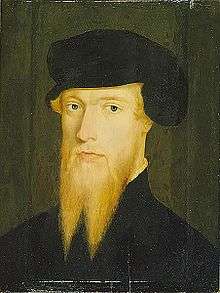
Erik XIV was crowned as king in 1561. He attempted to strengthen the monarchy even more in regard to the nobility and also to his brothers. To weaken their position, Erik founded new counties and baronships to divide the power of dukes. In Finland, the king's politics also resulted in new lawspeakers being appointed to the country. In 1561 the king approved the so-called Arboga articles at a diet, which submitted the dukes to the king's control and stripped them of a chance for independent foreign politics.
Destroying the position of John, the duke of Finland, was important to the king. As John's duchy, Finland became a "feudal minicountry" subject to the realm, with its own chancery, tax chamber and council, which could be compared to a state council. John's prerogatives in Livonia were also in conflict with the king: through a planned marriage with Catherine Jagiellon, John could receive numerous castles under his power in Livonia. At the same time, Erik XIV was being driven to war with Poland because of his expansion politics directed at Livonia. In 1561, the Tallinn city council had already given the city to the protection of the king, and during the same spring the Virumaa and Harjumaa nobility also resigned from the German knighthood.
The struggle for power
After the conflict had intensified, the king assembled a diet in 1563, where John was sentenced to death. The development led to the siege of the Turku Castle in summer 1563. After conflicts and bombardments, the castle surrendered on 12 August 1563, after which the luxury of the castle was destroyed, the duke and his wife were arrested and sent to Sweden for imprisonment. In the 1560s, Swedish foreign policy was marked by war against Poland in the Baltics. As well as this, Erik XIV was driven to war against Denmark-Norway and Lübeck. This required good relations to the east: concentrating military forces elsewhere required good relations towards Moscow. Erik XIV's era ended in 1568 after the nobility rose up against the king. This time even the Finnish nobility was on the side of the rebels, both old supporters of John and Erik's trusted men. The Turku Castle fell under the power of the rebels. Erik spent the next years in prison, until he was sentenced to death and poisoned in 1577.
The long wrath
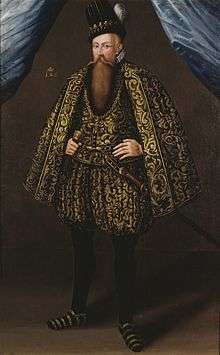
Under the reign of John III of Sweden, the border conflicts at the border of Käkisalmi county led to a new war (1570–1595), which is now known as the "25-year war". It was mostly a brutal war with guerilla warfare on both sides. In its beginnings, the war was well organised, and there was a truce on the Finnish front from 1573 to 1577. In the middle of the decade the peasant conflicts started again: the Karelians attacked in the direction of Oulujärvi and Iijoki, forces from Southern Finland travelled across the Gulf of Finland. At the end of the decade, organised warfare started again with an attack to Narva (1579) and the conquest of Käkisalmi in 1580. Narva was conquered the next year, after which negotiations led to an interim peace lasting until the year 1590. Despite the interim peace, guerilla warfare continued on both sides of the eastern border, which led to Kainuu and Northern Ostrobothnia being largely deserted in the 1580s. Led by Pekka Vesainen, the Ostrobothnians made vengeance trips to Viena Karelia. The war ended in 1595 with the Treaty of Teusina.
A new struggle for the throne
After John III died in 1592, the throne was left vacant. There were two candidates for his successor: Sigismund and the duke Karl. The question of the monarchy was entwined with the church politics: in the time of the counter-reformation in Europe Sigismund was a Catholic, which made his position even more problematic in the Lutheran Sweden. In 1593, Sigismund arrived in the country to be crowned. He gave his oath as a ruler in the autumn of the next year. At the same time, he accepted the Lutheran line of the Uppsala estate and church meeting (1593). With Sigismund's coronation, a personal union between Sweden and Poland, lasting a few years, was born; Sigismund was king of Poland until 1632.
After the king returned to Poland, conflicts arose among the nobility about Karl's position as a regent. In this conflict, Finland's leader Klaus Fleming sided with the king. At the Arboga diet in 1597, Karl was still named as regent. At this time, he declared his opponents, especially Klaus Fleming, to be rebels.
Justice becomes stricter
In general, secular courts in Europe during the start of the New Age in the 16th and 17th centuries started using the so-called "Law of Moses", that is to say, some parts of the Bible. According to the Law of Moses, witchcraft and magic was forbidden, and for example blasphemy, swearing, betraying one's parents, perjury, killing, demanding too high interest, false testimony and numerous sexual crimes could be punished by death. The Law of Moses became a general guide of justice in the Swedish realm in 1608 and remained in force until the new law of the realm in 1734. However, the law was often not used to the full extent of its cruelty, and death penalties were replaced with lesser penalties in about half of the cases.[9][10]
The peasant unrest in the 16th century and the Cudgel War
Unrest increased among the peasants during Gustav Vasa's reign, because of both heightened taxes and the struggle for power amongst his sons. The unrest resulted in the Cudgel War from 1596 to 1597. It ended bloodily, with the army beating the Ostrobothnian and Savonian peasants, armed by cudgels, spears and bows. The rebellion in Finland was directed at the nobility in power and especially at Klaus Fleming. The rebels sought help from the duke Karl who had been trying to usurp the throne. According to current research, the reasons for the rebellion included strain left from the 25-year war, financial setbacks and suffering caused by the castle camp system. Researchers disagree on how big an effect the duke Karl's leading the rebels against Klaus Fleming had on the outbreak of the Cudgel War.[11][12]
The superpower age (1617–1721)
The Treaty of Stolbovo
_en2.png)
From 1604 to 1611, the duke Karl of Södermanland was king Charles IX of Sweden. During his reign, the realm was almost constantly at war with Russia and Poland, especially about the ownership of the Baltic lands of Estonia and Livonia. Also, a war with Denmark was fought from 1611 to 1613, resulting in a loss for Sweden. After Charles IX died, his son Gustav II Adolf inherited the throne. The realm was in a bad state and Sweden had to sign a peace treaty with Denmark in 1613. The Treaty of Stolbovo was signed with Russia in 1617, which resulted in the Käkisalmi county, Nöteborg and part of Ingria being annexed into Sweden.
Modernisation and renewals
Under the leadership of the king and the chancellor of state Axel Oxenstierna, significant renewals were made in Sweden and Finland once the foreign political situation had calmed down. The army and the military organisation were reorganised especially based on the model of the Dutch Mortis of Orania. The realm received a new form of government and was divided into counties. Also, a Governor General was appointed to Finland in the 17th century to improve the conditions in the country. Governor Generals of Finland included Niels Bielke and count Per Brahe the Younger, whose official residence was the Turku Castle. During the superpower age, new cities were founded in Finland, as well as the Turku court of justice and in 1640, Finland's first university, the Royal Academy of Turku.
The Thirty Years' War
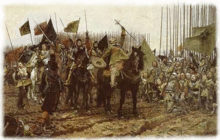
In the Baltics, Sweden was still at war with Poland, and in 1629 the temporary Truce of Altmark was made. In Germany, Gustav II Adolf joined the Thirty Years' War between the Catholic emperor and the Protestant princes in 1630 after making landfall in Northern Germany. Sweden's aim in the war was to support the German Protestants and strengthen its own position. However, Gustav II Adolf died in the Battle of Lützen in 1632 and his daughter Christina succeeded him on the throne while still a minor. In practice, the realm was ruled by a caretaker government led by Axel Oxenstierna. In the Peace of Westphalia that had ended the Thirty Years' War in 1648, Sweden secured its position as a superpower. However, the Thirty Years' War and other conflicts in the superpower age drained Sweden's and Finland's resources badly. A significant part of the peasants had to serve in the army and the navy, and many of them died in service.
From the wars to the age of peace
During Christina's reign from 1632 to 1654, a large amount of lands were given as feudal lands to the nobility. The nobility had the right to collect taxes on their lands, which made the crown's financial position more difficult. After Christina had renounced the crown, Charles X Gustav of Sweden followed her on the throne and ruled over the Swedish realm from 1654 to 1660. Charles X died in 1660, and was followed by Charles XI of Sweden, during whose reign from 1660 to 1697, a large reduction was made, which returned most of the feudal lands to the crown. Charles XI weakened the power of the nobility and ruled the realm as an autocrat. Charles XI's reign meant a long time of peace for Finland. The Protestant clergy was responsible for teaching literacy to the people, and clerical life was dominated by religious purism. From 1695 to 1697 Finland was devastated by the Great Famine, which resulted in a significant part of the population dying of hunger and illnesses.
The Great Northern War
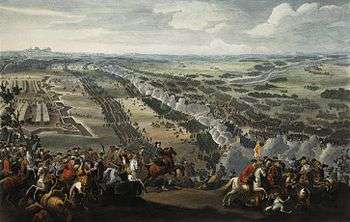
During the reign of Charles XI's successor Charles XII of Sweden, the Great Northern War erupted in 1700, resulting in Sweden losing its superpower position. The cause of the war was an alliance against Sweden made by its enemies Denmark, Russia, Poland and Saxony. In the 1617 Treaty of Stolbovo, Russia had lost its connection to the Baltic Sea. The renovation-minded czar Peter the Great sought to reopen a connection to the Baltic Sea for Russia, so that its connections and trade to Western Europe would become easier.
Although Charles XII managed to beat Denmark, Russia's attacking troops (in the Battle of Narva) and Poland, one at a time, the Swedish finally suffered a decisive defeat to the Russians in the Battle of Poltava in 1709. After this, the king fled to Turkey and the realm was open to an enemy attack. Vyborg was conquered in 1710, and the Russians occupied the rest of Finland after the Battle of Pälkäne in Pälkäne, the Battle of Storkyro in Ostrobothnia and the Battle of Gangut in front of Hanko by 1714. The Russian invasion period from 1714 to 1721 is commonly called the Greater Wrath. The occupation period was destructive to Finland. Thousands of people were killed and even more were sent to Russia, and a large part of the country's officials and clergy fled to Sweden. The Great Northern War and the Greater Wrath ended in the Treaty of Nystad in 1721. In the treaty, Ingria, Estonia, Livonia, the Käkisalmi county and Vyborg were annexed to Russia. The part of Karelia annexed to Russia is commonly called Old Finland.
The Age of Liberty and the Gustavian Age (1721–1809)
Power away from the king

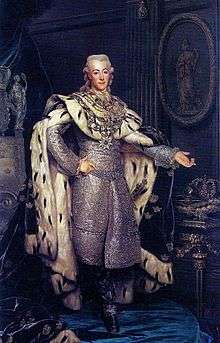
In the Swedish realm after Charles XII, the estates took power away from the king in the 1719 and 1720 governments and the age of autocracy changed into the age of estate rule (the "Age of Liberty"). Economy and science progressed during this age, but on the other side, power politics among parties caused problems. France and Russia gained power in Sweden by financing competing parties, which were called the Caps and the Hats.[13]
The Hats' War
The Hats' rise to power in the 1738–1739 diet led to a Russophobic foreign policy, which was a disadvantage for Finland. An attack war against Russia, known as the Hats' War, erupted in 1741. Sweden suffered a defeat in the battle of Lappeenranta in the same year, and the later stages of the war fared no better for it. In 1742, the Swedish army withdrew from a Russian attack and surrendered. Russia occupied Finland again from 1742 to 1743. This occupation period is known as the Lesser Wrath. The Russian empress Elizabeth spread a manifesto in 1742, urging Finns to abandon Sweden and form an autonomous state protected by Russia. However, after the occupation of Finland, promises of autonomy stopped.[14] The occupation ended in the Treaty of Åbo. The occupation during the Lesser Wrath did not cause as much damage as the longer and more violent Greater Wrath a couple of decades earlier.
Thoughts in the new age
After the war, the mercantilist principles in the trade led to the financial gain from tar and shipbuilding being left in Stockholm. In 1760, Anders Chydenius, the vicar of Kokkola, started demanding freedom of trade and speech.[13] During the last decades of the 18th century, interest to Finnish history and Finnish national poetry arose in the Royal Academy of Turku, especially because of Henrik Gabriel Porthan, the "father of Finnish history".[15] Of the researchers, Eino Jutikkala says: "People in various regions and of various estates in Finland in the late 18th century consciously considered themselves as Finnish as opposed to the Swedish who lived on the other side of the sea."[16]
The restless reign of Gustav III
In 1772, after Gustav III of Sweden had seized power, a new constitution was made, giving power back to the king. The age tried to get rid of mercantilism. Freedom of speech and freedom of religion expanded. Finnish officers trusted the king less, because the nobility lost their power to the king, who was supported by the people. Some high-ranking soldiers moved to serve in Russia.[13]
From 1788 to 1790, the so-called Gustav III's war, started by Gustav III, was fought between Sweden and Russia. Sweden was also confronted by Denmark. The officers in the Anjala conspiracy, among others, opposed the war. Despite a marine victory at the Battle of Svensksund, Sweden did not gain any new territories in the Treaty of Värälä. The Union and Security Act of 1789 strengthened the king's power even more. With the war, the nobility grew even more bitter towards the king, and this eventually led to the king's murder in 1792.[13]
Sweden loses Finland
The Finnish War was fought from 1808 to 1809 between Russia and Sweden. The reason for the war were the Treaties of Tilsit made between Russia and France on 7 July 1807. In the treaties, France and Russia had become allies and Russia had promised to pressure, with armed force if necessary, Sweden and other countries to join the Continental System against the United Kingdom, an embargo that France would have used to strengthen its position against the maritime power of the United Kingdom.
Finland's last ruler under Swedish rule was from 1802 to 1805 Gustav IV Adolf's second son Karl Gustaf, who died as an infant.[17] As a result of the Finnish War, Finland went under Russian rule and the government was based on autonomy. The Emperor of Russia became the Grand Duke of the autonomous Grand Duchy of Finland.
References
- ↑ Englund, Peter: Suuren sodan vuodet, Finnish language version, introduction. See also: finnica.fi.
- ↑ "Suomi osana Ruotsin valtakuntaa". finnica.fi.
- ↑ Korpela, Jukka: Häme Bysantin ja Rooman välissä ennen Pähkinäsaaren rauhaa. In Linder, M.-L. et al. (ed.): Ristin ja Olavin kansaa. Keskiajan usko ja kirkko Hämeessä ja Satakunnassa. Publications of the museums of Tampere 55. Tampere 2001.
- ↑ Holappa, Veli: Verot ja oikeuslaitos 1500-1600 -luvulla: Keskiaikainen oikeudenkäyttö
- ↑ Katajala, Kimmo: Suomalainen kapina, p. 136.
- ↑ Ylikangas, Heikki: Nuijasota, p. 174.
- ↑ Katajala, pp. 124–137.
- ↑ Salminen, Tapio: Suomen linnojen ja voutikuntien hallinto 1412-1448, pp. 37–38. Master's thesis, University of Tampere 1993.
- ↑ Nenonen, Marko; Kervinen, Timo: Finnish witch trials in synopsis (1500-1750)
- ↑ Jumalan laki astuu voimaan
- ↑ Katajala, Kimmo: Miksi nuijasota syttyi Pohjanmaalla?
- ↑ Ylikangas, Heikki: Nuijasota, 1997, pp. 358–359. ISBN 951-1-14253-4.
- 1 2 3 4 "Suomi - Vapauden ja hyödyn aika". fennica.fi.
- ↑ Pieni tietosanakirja: Suomi, pp. 478–490.
- ↑ Porthan-Seura
- ↑ Jutikkala-Pirinen: Kivikaudesta Koivistoon, 1989, pp. 194, 196, 205, the same in the 2002 edition.
- ↑ Juva, p. 114; Cederberg, A. R.: Suomen historia vapauden ajalla, I-II, 1942 and 1947.
Bibliography
- Vahtola, Jouko: Suomen historia: Jääkaudesta Euroopan unioniin. Otava, 2003, Helsinki (4th edition 2005). ISBN 951-1-17397-9.
- Zetterberg, Seppo (ed.): Suomen historian pikkujättiläinen. WSOY, 1987, Helsinki. ISBN 951-0-14253-0.
- Korhonen, Arvi (ed.): Suomen historian käsikirja, previous part. WSOY, 1949, Porvoo – Helsinki.
- Karonen, Petri: Pohjoinen suurvalta: Ruotsi ja Suomi 1521-1809. WSOY, 1999, Helsinki. ISBN 951-0-23739-6.
- Pohjolan-Pirhonen, Helge: Suomen historia 1523-1617. WSOY, 1960, Porvoo – Helsinki.